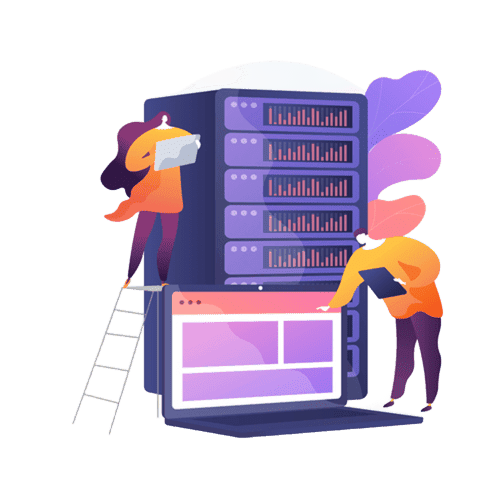[dsm_gradient_text gradient_text="Maintaining ISO 27001 Compliance: Tips for Long-Term Success" _builder_version="4.27.0" _module_preset="default" header_font="Questrial|||on|||||" header_text_align="center" header_letter_spacing="5px" filter_hue_rotate="100deg"...
Cooling the Future: How AI Makes Data Centers Greener
Every time you stream a movie, store files in the cloud, or ask an AI model a question, a data center somewhere in the world springs into action. These sprawling facilities are the beating heart of our digital society, housing thousands of servers that power everything from banking systems to video games. But behind the convenience of instant access to information lies a less glamorous truth: data centers are some of the most energy-hungry infrastructures on the planet.

The Hidden Energy Guzzlers of the Digital Age
According to recent estimates, data centers already consume 1 – 2% of the world’s total electricity, and this figure is projected to climb as artificial intelligence, edge computing, and cloud services continue to scale. For governments and companies alike, the challenge is clear, how can we keep feeding the digital economy without draining the planet’s energy resources or blowing past climate goals?
At the center of this challenge sits an often-overlooked villain: cooling. Servers generate enormous amounts of heat, and without proper thermal management, performance plummets and hardware can fail. Cooling systems can account for up to 40% of a data center’s total energy consumption, making them the Achilles’ heel of efficiency. Traditional cooling approaches, like air conditioning or simple liquid cooling setups, struggle to keep up with the scale, density, and variability of modern workloads. The result? Over-engineered systems that waste energy in low-load conditions and risk overheating when demands spike.
This is where artificial intelligence (AI) enters the picture. AI doesn’t just automate, it learns, predicts, and adapts. By analyzing patterns in temperature, workload, and power usage, AI can anticipate when cooling will be needed and optimize how it’s delivered. Instead of blasting servers with cold air or coolant based on static rules, AI-driven systems dynamically adjust in real time, keeping conditions stable while cutting unnecessary energy use. The promise is bold: smarter cooling that makes data centers not just faster, but greener.
In this blog post, we’ll explore how researchers are combining cutting-edge machine learning models like Transformers and Gated Recurrent Units (GRUs) to tackle one of the toughest problems in digital infrastructure: predictive cooling optimization. We’ll look at why this matters, how it works, and what it means for the future of sustainable computing.
%
total energy is used for cooling
Approx. 40% of a data center’s total energy is used for cooling. Source: McKinsey
The Energy Burden of Data Centers
When you think of the world’s biggest energy consumers, what comes to mind? Heavy industry? Airlines? Oil refineries? Here’s a surprise: the internet itself is in the same league. Behind every TikTok video, Zoom meeting, or AI chatbot conversation sits an invisible giant: data centers.
Globally, data centers now account for roughly 1 – 2% of all electricity use, a number comparable to the entire energy consumption of some mid-sized nations. And that percentage is climbing fast. As cloud services expand, as AI models grow larger, and as billions more devices come online, the demand for computing, and the electricity to power it, will skyrocket. If left unchecked, the world’s digital backbone could become one of its biggest carbon culprits.
To keep this growth sustainable, the industry uses a common yardstick: Power Usage Effectiveness (PUE). Think of PUE as the miles per gallon for data centers. A perfect score would be 1.0, meaning that every watt of electricity goes directly into running servers and none is wasted elsewhere. In reality, most data centers score between 1.2 and 2.0. That gap, those extra watts, are mostly swallowed up by cooling systems. In other words, for every unit of power that fuels computing, nearly half a unit might be spent just keeping the machines from overheating.
The problem is that air cooling, the long-time workhorse of data centers, is starting to buckle under pressure. Blasting rows of servers with cold air may have worked when workloads were smaller and racks were less dense, but modern computing is a different beast. High-performance servers, especially those running GPUs for AI, run hotter and pack tighter. Fans and air conditioners have to work harder and harder, guzzling electricity while often failing to keep temperatures steady. It’s like trying to cool a rocket engine with a desk fan—expensive, inefficient, and unsustainable.
Enter liquid cooling, the technology that’s quickly becoming the industry’s new standard. Instead of pushing air around a room, liquid cooling systems deliver coolant directly to the source of heat, whether through pipes, cold plates, or immersion tanks. Because liquids are far more effective at absorbing heat than air, they can carry away thermal loads faster and with far less energy. That means cooler servers, lower costs, and greener operations.
But here’s the catch: even liquid cooling isn’t automatically efficient. How coolant flows, how temperatures are managed, and how the system adapts to fluctuating workloads can make or break performance. And that’s exactly where AI-powered prediction and control promise to transform the game.
Liquid Cooling Systems in Data Centers
Imagine running a marathon in the middle of summer, but instead of drinking water, someone hands you a fan. It might make you feel a little better, but it’s not going to keep your body from overheating. That’s essentially the problem with air cooling in modern data centers, it just isn’t enough anymore. Liquid cooling is the water bottle marathon runners desperately need.
How Liquid Cooling Works
Liquid cooling isn’t about dunking servers into water (though immersion cooling is actually a real technique). Instead, most large-scale systems rely on coolant loops, closed circuits of chilled liquid that move heat away from servers and out into the environment. Here’s the basic setup:
- Tertiary Loop (closest to the servers): This is the front line, where coolant runs through cold plates or heat exchangers attached directly to CPUs, GPUs, and other components. It absorbs the intense heat generated by the processors.
- Secondary Loop (the middle layer): Once the coolant collects heat from the servers, it flows into a secondary loop. This acts like a transfer hub, moving heat away from the racks and toward facility-level cooling systems. It may also include waste heat recovery units, which can redirect excess warmth to heat office spaces or even nearby buildings.
- Primary Loop (the final stage): This loop connects to cooling towers, where the collected heat is released into the outside air, usually through evaporation. In some designs, it might also connect to chillers or other large-scale heat exchangers.
The three loops work together like a relay race: the tertiary loop absorbs heat, the secondary loop passes it along, and the primary loop gets rid of it.
Why It’s Better Than Air Cooling
The secret weapon of liquid cooling is simple physics: liquids carry heat far more efficiently than air. A liter of water can absorb about 3,500 times more heat than the same volume of air. That means you can move a lot more thermal energy with less effort. Compared to air cooling, liquid systems offer:
- Higher efficiency: Less power wasted on giant fans and air conditioning units.
- Higher density: Servers can be packed more tightly because cooling is more direct.
- Stability: Coolant temperatures are easier to keep within narrow ranges, protecting sensitive hardware.
- Sustainability: Many systems can reuse waste heat, turning a problem into an opportunity.
It’s no wonder hyperscale operators like Google, Microsoft, and Amazon are all experimenting with liquid cooling for their next-generation data centers.
Bottlenecks and Inefficiencies
But liquid cooling isn’t a silver bullet. Even the most advanced systems can stumble if they aren’t managed intelligently. Common pitfalls include:
- Overcooling: Running pumps and chillers at maximum power just to be safe wastes huge amounts of energy.
- Flow imbalances: If one loop has lower flow than others, hotspots can form, much like a clogged artery in the human body.
- Temperature fluctuations: Workloads in data centers aren’t constant. A sudden spike in GPU activity can overwhelm a poorly tuned system.
- Complexity: With multiple loops, pumps, and heat exchangers, the system itself can become a maze of interdependencies that’s hard to control manually.
That’s why operators are increasingly turning to AI-powered prediction and optimization. Instead of reacting to problems after they occur, AI can forecast temperature shifts before they happen, adjusting coolant flows and pump speeds on the fly. It’s like upgrading from a driver constantly hitting the brakes and accelerator to one who can actually see the road ahead.
Why Predictive Cooling is Necessary
If you’ve ever tried to cook pasta on a stove without paying attention, you know what happens, leave it too long, and it boils over; take it off too early, and it’s undercooked. Managing the temperature inside a data center is a bit like that, only with millions of dollars’ worth of hardware at stake.
Dynamic Workloads, Dynamic Heat
Unlike your home computer, which might idle for hours and only spike during a video call or a game, data center servers rarely rest. Some handle massive AI training runs, others stream live video to millions of people, and still others crunch financial transactions nonstop. Workloads surge and shrink unpredictably, hour by hour, minute by minute.
These shifts translate directly into thermal loads. A rack that was cool and steady five minutes ago can suddenly be pumping out enough heat to roast a turkey when GPUs hit full throttle. Cooling systems that can’t adapt quickly risk either wasting energy or failing to protect critical hardware.
The Limits of Rule-Based Cooling
For years, many data centers have relied on rule-based cooling: simple if-then statements like If coolant return temperature > 30°C, increase pump speed. It’s easy to set up, but it treats a data center like a machine with just two settings: on and off. The problem is, modern facilities are far too complex for static rules:
- Heat doesn’t rise evenly across racks or zones.
- External weather conditions can affect cooling tower efficiency.
- Different applications running on different servers generate wildly different heat signatures.
Relying on manual adjustments or fixed thresholds is like trying to steer a car on an icy road using only your rearview mirror, you’re always reacting too late.
The Cost of Overcooling vs. Undercooling
This reactive approach creates two equally painful outcomes:
- Overcooling (too much safety buffer): Pumps and chillers run harder than needed just in case. This wastes vast amounts of electricity and water, driving up operational costs and carbon footprints. It’s like cranking your home AC to 16°C all summer you’ll stay cool, but your utility bill will be monstrous.
- Undercooling (falling behind demand): When rules or manual monitoring can’t keep up with workload spikes, servers overheat. Even small temperature excursions can shorten hardware lifespan, cause crashes, or in worst cases, trigger emergency shutdowns. That’s like waiting until your car engine light comes on to add coolant, you’re already in trouble.
Neither option is sustainable. What data centers need is a system that can anticipate changes, not just respond to them. That’s where predictive cooling, powered by artificial intelligence, becomes essential. By forecasting thermal loads before they occur, AI can fine-tune cooling resources in real time delivering just the right amount of cooling, exactly where and when it’s needed.
In short: predictive cooling turns a clunky, reactionary process into a proactive, intelligent strategy, keeping data centers efficient, resilient, and green.
Artificial Intelligence for Cooling Optimization
Cooling a modern data center is like conducting a symphony. There are hundreds of instruments pumps, fans, heat exchangers, coolant loops, all playing at once. If they’re out of sync, the result is chaos: wasted energy, unstable temperatures, and hardware at risk. For decades, we relied on sheet music made of simple rules, but today the orchestra has grown too large and too complex. It’s time for a new conductor: artificial intelligence.
From Rules to Learning Machines
The first wave of data center cooling management was rule-based. Engineers hard-coded thresholds: If the temperature hits 30°C, spin up the fans. If it drops below 20°C, slow them down. This worked for small facilities, but as workloads became unpredictable and equipment more diverse, these rigid rules began to crack.
Next came machine learning (ML). Instead of relying on hard-coded rules, ML models could be trained on historical data to recognize patterns. For example, they might learn that traffic spikes on Monday mornings tend to drive GPU temperatures higher than at other times. This allowed systems to make smarter, data-driven adjustments instead of blind reactions.
But the real leap forward has come with deep learning (DL). Using neural networks especially time-series models like LSTMs, GRUs, and Transformers AI can not only recognize past patterns but also forecast the future. In other words, instead of just noticing it’s getting hot, deep learning can say, based on the workload coming in and the weather outside, this rack will hit 35°C in 10 minutes better increase coolant flow now.
IoT and Sensors: The Nervous System of Smart Cooling
None of this intelligence works without data. That’s where the Internet of Things (IoT) comes in. Modern data centers are bristling with sensors that measure:
- Temperature at the inlet and outlet of racks.
- Coolant flow rates across different loops.
- Humidity and air pressure in server rooms.
- Power draw of CPUs, GPUs, and facility equipment.
These sensors feed a constant stream of real-time data into predictive models. Think of them as the nervous system of the data center, detecting even the slightest changes in environment and workload. With this sensory input, AI doesn’t have to guess, it can see exactly what’s happening and predict what will happen next.
The Benefits of AI Cooling Optimization
So why go through the trouble of wiring an AI brain into the cooling system? Because the payoff is massive:
1. Real-Time Adaptation. AI can adjust cooling strategies on the fly, balancing pump speeds, coolant flows, and fan operations second by second. This prevents wasteful overcooling while avoiding dangerous hot spots.
2. Anomaly Detection. With constant monitoring, AI can flag issues that human operators might miss like a pump starting to fail or a loop behaving abnormally. Early warnings mean maintenance can be scheduled before small problems become disasters.
3. Forecasting and Planning. Predictive models allow operators to plan ahead. For example, if an AI system knows a massive AI training job will start in the next hour, it can pre-cool the system just enough to handle the surge, then scale back once the load drops.
The result is a cooling system that’s not just responsive, but proactive a system that saves energy, extends hardware life, and makes the entire data center more resilient.
In short: AI turns cooling from a cost center into a competitive advantage.
Inside the Transformer-GRU Model
So how exactly can artificial intelligence predict the future heat of a data center? The answer lies in combining two powerful deep learning architectures Transformers and Gated Recurrent Units (GRUs). Each has unique strengths, and when fused together, they create a predictive model that’s greater than the sum of its parts.
Transformers: Masters of Attention
Transformers first rose to fame in natural language processing, powering chatbots and translation engines. But their secret weapon, the self-attention mechanism, is just as useful for cooling prediction as it is for understanding sentences. Here’s why:
- Self-Attention: Imagine trying to predict tomorrow’s coolant temperature. Instead of only looking at the most recent reading, self-attention lets the model compare every point in the timeline to every other point. It learns which past temperatures, workloads, and flow rates matter most for predicting the future.
- Multi-Head Attention: Rather than one perspective, Transformers use multiple heads, each looking at the data differently, one might focus on short-term spikes, another on long-term seasonal trends. These views are then combined into a richer picture.
- Positional Encoding: Unlike humans, models don’t inherently know the difference between yesterday and last month. Positional encoding fixes this by injecting a sense of time into the data, so the model understands when events occurred in the sequence.
The result? Transformers are brilliant at teasing out global patterns across long stretches of time.
GRU vs. LSTM: A Simpler Gatekeeper
Before Transformers, the go-to models for time series were LSTMs (Long Short-Term Memory networks). They’re good at remembering both recent and distant events by using three gates (input, output, forget). The downside is that LSTMs are computationally heavy, lots of parameters, longer training times.
GRUs (Gated Recurrent Units) came later as a streamlined cousin:
- They use just two gates (update and reset), making them lighter and faster.
- They require fewer resources while still solving the vanishing gradient problem that crippled older RNNs.
- For many tasks, GRUs perform on par with LSTMs but with less overhead perfect for real-time systems where speed matters.
In short: LSTMs are like a Swiss Army knife, GRUs are a sleek multitool, simpler, but still powerful.
Why Combine Transformers and GRUs?
On their own, Transformers excel at capturing long-range dependencies, while GRUs shine at handling short-term fluctuations efficiently. Data center cooling involves both:
- Long-term patterns (seasonal changes, daily workload cycles).
- Short-term bursts (a sudden GPU-intensive workload, or a spike in user traffic).
By combining the two:
- The Transformer encoder extracts rich features and identifies global patterns.
- The GRU layer takes those features and focuses on short-term dynamics, updating predictions efficiently in real time.
It’s like having a weather satellite (Transformer) that gives you the big picture, and a local weather station (GRU) that fine-tunes the forecast for your neighborhood.
Computational Trade-offs and Optimizations
Of course, all this intelligence comes at a cost. Transformers are notoriously hungry self-attention scales with the square of the input length, meaning long sequences can balloon computational requirements. That’s why the model in this study trims the Transformer down to just the encoder side, reducing complexity while still reaping the benefits of attention. The GRU then adds efficiency:
- It processes sequences step by step, with fewer parameters than an LSTM.
- It balances the Transformer’s heavy computations, keeping the overall model nimble enough for real-time prediction.
Even so, optimizations are still necessary. Techniques like sparse attention, sequence length reduction, or even lightweight Transformer variants can further cut computational costs without sacrificing accuracy. The payoff? A model that achieved state-of-the-art performance lower prediction errors and higher accuracy than competing methods, while remaining feasible for real-world data center environments.
Case Study: Frontier Supercomputer at Oak Ridge National Laboratory
If data centers are the engines of the digital world, then supercomputers are Formula 1 race cars blisteringly fast, incredibly powerful, and just as demanding when it comes to cooling. And right now, the crown jewel of high-performance computing is Frontier, housed at the Oak Ridge Leadership Computing Facility (OLCF) in Tennessee, USA.
Meet Frontier: The World’s First Exascale Supercomputer
Frontier isn’t just fast, it’s history-making. Built by Hewlett Packard Enterprise (HPE) and Cray, it’s the first machine to officially break the exascale barrier, capable of performing more than a quintillion calculations per second (10¹⁸). That’s so powerful it could crunch through every chess move ever played in human history in the blink of an eye.
This power comes from a vast architecture:
- 74 computing racks, each with 64 blades.
- 9,402 nodes in total, each node packing four GPUs and one CPU.
- Over 4 terabytes of flash memory per node, connected through high-speed interlinks.
But with great power comes great heat. Running at full tilt, Frontier can consume between 8 and 30 megawatts of power enough to supply thousands of homes. All that energy doesn’t just vanish, it turns into heat that must be removed quickly and efficiently.
The Liquid Cooling Gauntlet
To keep Frontier from cooking itself, ORNL uses a three-tier liquid cooling system:
- Tertiary loop: Coolant flows through cold plates directly attached to CPUs and GPUs, slurping heat straight off the silicon.
- Secondary loop: Transfers that heat to larger facility cooling systems, including a waste heat recovery sub-loop that reuses warmth to heat water for buildings.
- Primary loop: Cooling towers outside the facility finally disperse excess heat into the atmosphere.
This isn’t a trickle of water, it’s a flood. Thousands of gallons of coolant move through Frontier’s veins every minute, creating a delicate balancing act: too little flow, and hotspots emerge; too much, and energy is wasted.
The Data Behind the Predictions
Frontier is wired up like a patient in a high-tech hospital. ORNL’s building automation system records a torrent of data points every 10 minutes:
- Coolant supply and return temperatures.
- Flow rates in different loops.
- Waste heat levels.
- Facility power usage.
- PUE (Power Usage Effectiveness) measurements.
Over an entire year, this creates a massive dataset, perfect fuel for training AI models. By analyzing this data, researchers can predict how coolant temperatures will behave under different workloads, then fine-tune the cooling system to minimize waste.
Why Frontier Is the Perfect Testbed
Testing predictive cooling on Frontier isn’t just about one machine. Supercomputers are stress tests for everything we know about data center design. If an AI model can keep up with Frontier’s volatile workloads, dense architecture, and colossal energy demands, it can be trusted in just about any modern data center. Frontier’s case also highlights the real-world stakes:
- Efficiency: Saving even a fraction of a percent of energy at a 30 MW facility translates to millions of dollars annually.
- Sustainability: Every megawatt saved reduces carbon emissions and water use.
- Reliability: A supercomputer used for climate modeling, nuclear safety, and AI research simply cannot afford downtime.
By proving AI can stabilize Frontier’s thermal rollercoaster, researchers are showing the way toward a future where cooling is predictive, adaptive, and sustainable from the world’s biggest supercomputers down to everyday cloud data centers.
Results of the Study: How Well Did the AI Perform?
When researchers set out to test their Transformer-GRU model on the Frontier supercomputer’s cooling data, they weren’t just hoping for a small improvement. They were aiming to answer a big question: Can AI really do better than the tried-and-true prediction methods? The results speak for themselves.
Accuracy that Outshines the Competition
The model was tasked with predicting coolant return temperatures, a critical factor for balancing cooling efficiency and stability. To evaluate performance, researchers compared the AI’s predictions to actual measurements using standard error metrics:
- MSE (Mean Squared Error)
- RMSE (Root Mean Squared Error)
- MAPE (Mean Absolute Percentage Error)
- R² (Coefficient of Determination)
The Transformer-GRU delivered:
- MSE: 1.349
- RMSE: 1.161
- MAPE: 0.0244
- R²: 81.07%
Those numbers might look abstract, but here’s the kicker: they were consistently better than rival models, including Transformer-LSTM, Informer, Reformer, DeepAR, plain GRU, LSTM, and even CNN-GRU.
In plain English? The hybrid AI model wasn’t just good, it was the best in class. It predicted coolant behavior more accurately, which means cooling systems could be adjusted more precisely, cutting waste without risking overheating.
Seeing the Predictions in Action
Graphs comparing predictions to actual measurements showed how closely the AI tracked reality. While other models wavered during sudden workload spikes, the Transformer-GRU stayed locked on target, anticipating changes before they spiraled out of control.
Think of it like weather forecasting: older models might tell you it’s sunny now, so it’ll stay sunny, while the Transformer-GRU says, actually, based on shifting winds, it’s going to rain in 15 minutes—grab an umbrella.
Sensitivity Analysis: Tuning the Model
The team didn’t stop at proving accuracy, they also tested how different hyperparameters (like batch size, time steps, and number of neurons) affected performance. The findings were fascinating:
- Epochs (training rounds): Too few, and the model didn’t learn enough; too many, and it overfit the data. The sweet spot was around 70 epochs.
- Time step: Shorter windows (like 32 data points) worked better, capturing quick fluctuations without drowning in noise.
- Neuron count & batch size: These influenced training efficiency more than accuracy, showing the model was robust even when scaled differently.
This level of analysis proved the model wasn’t a fragile black box, it was resilient across different setups.
Generalization: Beyond One Dataset
The researchers also checked whether the AI could handle different conditions: seasonal changes, varying load patterns, and even predictions of waste heat. The Transformer-GRU held strong, demonstrating that it could generalize beyond its training data. That’s crucial for real-world adoption, because no two data centers are exactly alike.
Why It Matters
Small percentages make a huge difference at scale. For Frontier, saving even 1% of cooling energy translates into:
- Hundreds of thousands of dollars saved annually.
- Lower carbon emissions by reducing both electricity and water usage.
- More reliable performance for one of the most important scientific machines on the planet.
Now imagine applying the same approach across thousands of cloud data centers worldwide. The energy savings alone would be staggering, and the environmental impact profound.
Broader Implications: From Supercomputers to the Cloud
The Frontier supercomputer may be one-of-a-kind, but the challenges it faces are universal. Every data center on Earth, from hyperscale facilities run by Amazon and Google to the racks tucked away in corporate basements, fights the same battle: how to keep servers cool without burning through energy and budgets. The success of the Transformer-GRU model at Frontier isn’t just a win for scientists, it’s a glimpse into the future of how the entire digital world could become greener and more efficient.
Hyperscale Operators and the Sustainability Mandate
The “big three” cloud giants, Amazon Web Services (AWS), Microsoft Azure, and Google Cloud, operate massive fleets of data centers. Together, they power everything from Netflix streaming to enterprise AI. They also consume vast amounts of electricity, with individual campuses sometimes requiring as much power as a small city.
These companies are under pressure to meet ambitious climate pledges:
- Google aims to run entirely on carbon-free energy by 2030.
- Microsoft has promised to be carbon negative by 2030.
- Amazon has pledged to achieve net-zero emissions by 2040.
Cooling is one of the biggest roadblocks to hitting those goals. If AI-powered predictive cooling can trim even a few percentage points off their energy bills, the scale of savings, both financial and environmental, is enormous.
Cost Savings at Scale
Consider this: Frontier’s cooling optimization could save hundreds of thousands of dollars annually. Now multiply that across thousands of hyperscale data centers worldwide. We’re talking billions in potential savings, money that can be reinvested in renewable energy, hardware upgrades, or new services.
For cloud providers operating on razor-thin margins in a hyper-competitive market, these efficiencies aren’t just nice to have, they’re strategic advantages. Being able to market a data center as not only faster but also greener could become a key differentiator for winning business.
Environmental Impact
Data centers already account for 1 – 2% of global electricity consumption, and demand is rising as AI adoption accelerates. Without smarter cooling, that footprint could double or triple in the coming decades. AI-enabled optimization helps flip the script: instead of being seen as climate villains, data centers can become leaders in sustainable technology infrastructure.
Moreover, predictive models don’t just save electricity. They also reduce water consumption, since cooling towers often rely on evaporation. In water-stressed regions, this could make AI-optimized cooling as much about resource survival as about cost.
Beyond Hyperscale: Enterprises and Edge Computing
While tech giants grab the headlines, predictive cooling has implications across the board:
- Enterprise data centers: Many corporations still run their own server rooms. AI-driven cooling could help them cut costs without massive infrastructure overhauls.
- Edge computing sites: As 5G and IoT expand, smaller, distributed data centers are popping up everywhere from cell towers to autonomous vehicle hubs. These edge sites often operate in less controlled environments, making predictive cooling critical for reliability.
In short, the benefits cascade down the entire digital ecosystem. From the largest exascale supercomputers to the smallest edge nodes, AI can turn cooling into a smart, adaptive system that scales with demand.
Challenges and Limitations: Why Predictive Cooling Isn’t a Magic Bullet
As promising as AI-powered cooling sounds, it’s not a plug-and-play miracle. Like any cutting-edge technology, it comes with its own hurdles—technical, operational, and even cultural. To make predictive cooling a global standard, these challenges will need to be addressed head-on.
Model Complexity and Computational Cost
Ironically, AI itself consumes a lot of energy. Training a Transformer-GRU model on massive datasets isn’t free, it requires significant computing resources. While once trained, the model can run efficiently in production, organizations must balance the carbon cost of training AI against the savings it promises. For hyperscale operators with deep pockets, this isn’t a deal-breaker. But for smaller enterprises or edge facilities, deploying heavy models could be prohibitive. Lightweight AI variants may be necessary to democratize adoption.
Generalizability Across Data Centers
Not all data centers are built alike. Frontier is a liquid-cooled exascale supercomputer with advanced infrastructure. Many facilities still rely on hybrid cooling, different sensor layouts, or less granular monitoring. A model trained on one system may not perform as well on another.
This raises a key challenge: how to adapt predictive models to diverse environments without retraining from scratch. Transfer learning and modular architectures may help, but the issue is far from solved.
Missing or Incomplete Data
AI is only as good as the data it ingests. Sensors can fail, readings can drift, and some facilities may lack the dense instrumentation needed for robust predictions. Without reliable IoT data, predictive cooling risks becoming just another black box that operators can’t fully trust.
External Factors Beyond Control
Cooling efficiency isn’t only determined by servers and coolant loops. External variables like humidity, ambient temperature, and even local weather patterns play huge roles. For example, a cooling tower in Arizona behaves very differently from one in Finland. While AI can incorporate weather data, modeling these variables accurately adds another layer of complexity.
Integration with Legacy Systems
Many data centers run on legacy building management systems (BMS) that weren’t designed for real-time AI optimization. Retrofitting these systems to accept AI-driven commands can be tricky, costly, and politically sensitive, especially in mission-critical environments where downtime is unacceptable.
Cultural and Organizational Barriers
Finally, there’s the human factor. Data center operators are naturally risk-averse; after all, uptime is everything. Trusting an AI system to make real-time cooling decisions can feel like handing the car keys to a self-driving vehicle. Adoption will require not just technical success but also cultural buy-in, training, and proof that AI can deliver results consistently.
So while predictive cooling is powerful, it’s not yet a universal solution. It’s a promising prototype for the future, but one that must evolve through iteration, trust-building, and smarter deployment strategies.
Future Directions: Toward Self-Optimizing Data Centers
If today’s AI-enabled predictive cooling is impressive, the road ahead promises something even more transformative. What we’re seeing now is just the first step toward a future where data centers are not just cooled intelligently, but run as autonomous, self-optimizing systems.
Lightweight Transformer Variants for Real-Time Control
While Transformer-GRU models deliver high accuracy, they can be heavy. Future work will focus on lightweight Transformer variants streamlined versions designed for faster inference with fewer parameters. Techniques like sparse attention or distillation can cut complexity without losing much predictive power. This would make it feasible to deploy predictive cooling even in smaller enterprise or edge data centers, where computing budgets are tighter.
Multimodal Data Integration
Right now, most predictive models rely heavily on thermal and workload data. But data centers are complex ecosystems influenced by everything from weather conditions to energy market prices. Future models could merge these diverse streams workload forecasts, ambient climate, electricity costs—into a unified prediction engine. Imagine an AI that not only predicts heat but also decides when it’s cheapest and cleanest to run workloads, aligning cooling with renewable energy availability.
Digital Twins: Simulation Meets Reality
One of the most exciting developments is the rise of digital twins—virtual replicas of physical systems. In a digital twin of a data center, AI could simulate millions of cooling scenarios before applying them in the real world. That means safer experimentation, faster optimization, and the ability to test what-if strategies, like handling unexpected heat waves or new server deployments, without risking downtime.
Autonomous Data Centers
Combine predictive cooling with automation across power management, workload distribution, and fault detection, and you get the blueprint for autonomous data centers. These facilities would require minimal human intervention, running like self-driving cars for the digital age. They could balance workloads, reroute power, and adjust cooling in real time, all while continuously learning and improving.
Integration with Renewable Energy and Heat Recovery
Looking beyond cooling, predictive AI could work hand-in-hand with renewable energy systems. For instance, if the model predicts a thermal spike during a time when solar power is abundant, it could pre-cool servers using green energy. Meanwhile, waste heat recovery systems could be optimized to provide heating for nearby communities, turning a problem into a resource.
The Long-Term Vision
The ultimate destination is clear: a net-zero digital infrastructure where every watt is accounted for and optimized. AI won’t just manage cooling it will orchestrate the entire symphony of energy use, from chips to chillers to the grid. The data center of the future won’t be a passive consumer of energy; it will be an active participant in the clean energy ecosystem.
In other words, predictive cooling is just the opening act. The real show is a new era of self-optimizing, sustainable digital infrastructure, where AI ensures that the world’s computing backbone grows smarter, faster, and greener with every passing year.
Conclusion
The story of data centers is the story of our digital age. From streaming and cloud storage to AI breakthroughs, nearly everything we do online flows through these humming halls of servers. But as the demand for computing grows, so too does the urgency to make it sustainable. Cooling, long the Achilles’ heel of efficiency, has finally met its match: artificial intelligence.
Think of AI as the nervous system of digital infrastructure. Just as the human body senses, predicts, and adjusts to keep itself in balance, AI can monitor temperatures, workloads, and energy flows in real time, keeping data centers cool without wasting precious resources. It’s not just a layer of automation; it’s a layer of intelligence that transforms how these facilities operate.
The journey is already underway at the cutting edge. At the exascale level, Frontier’s adoption of predictive cooling shows what’s possible in the most demanding environments on Earth. But this isn’t only about supercomputers. The same principles will trickle down to enterprise data centers powering corporations, and eventually to edge data centers sitting in cities, factories, and even cell towers. Everywhere computation happens, predictive cooling can follow.
Why does this matter? Because without smart cooling, our digital economy risks becoming an unsustainable energy drain. With it, we have a path to green growth expanding AI, cloud, and digital services while cutting carbon emissions and conserving resources. Predictive cooling is more than an efficiency upgrade; it’s a cornerstone of the sustainable, AI-driven world we’re building.
The vision is bold but within reach: self-optimizing, carbon-neutral data centers that adapt like living systems, orchestrated by AI to align with renewable energy, reuse waste heat, and maximize every watt of power. In this future, computing won’t be the villain of the climate story, it will be one of its heroes.
The digital age has always been about possibility. Now, with AI guiding the way, it can also be about responsibility. Predictive cooling is where those two threads meet, ensuring that the next era of innovation is not just faster and smarter, but cleaner and greener, too.
References
- Science Direct: AI-driven cooling technologies for high-performance data centers
- Microsoft: Next-generation datacenters consume zero water for cooling
Wanna know more? Let's dive in!
ISO 27001 Explained: What It Is and Why Your Business Needs It
[dsm_gradient_text gradient_text="ISO 27001 Explained: What It Is and Why Your Business Needs It" _builder_version="4.27.0" _module_preset="default" header_font="Questrial|||on|||||" header_text_align="center" header_letter_spacing="5px" filter_hue_rotate="100deg"...
The Road to ISO 27001 Certification: A Step-by-Step Guide
[dsm_gradient_text gradient_text="The Road to ISO 27001 Certification: A Step-by-Step Guide" _builder_version="4.27.0" _module_preset="default" header_font="Questrial|||on|||||" header_text_align="center" header_letter_spacing="5px" filter_hue_rotate="100deg"...
ISO 27001 vs. Other Security Standards
[dsm_gradient_text gradient_text="ISO 27001 vs. Other Security Standards: Which One Is Right for You?" _builder_version="4.27.0" _module_preset="default" header_font="Questrial|||on|||||" header_text_align="center" header_letter_spacing="5px"...
Top Psychological Hazards Identified by ISO 45003—and How to Address Them
[dsm_gradient_text gradient_text="Top Psychological Hazards Identified by ISO 45003" _builder_version="4.27.0" _module_preset="default" header_font="Questrial|||on|||||" header_text_align="center" header_letter_spacing="5px" filter_hue_rotate="100deg"...
How to Implement ISO 45003: A Step-by-Step Guide
[dsm_gradient_text gradient_text="How to Implement ISO 45003: A Step-by-Step Guide" _builder_version="4.27.0" _module_preset="default" header_font="Questrial|||on|||||" header_text_align="center" header_letter_spacing="5px" filter_hue_rotate="100deg" hover_enabled="0"...
Common Pitfalls in Applying ISO 31000 And How to Avoid Them
[dsm_gradient_text gradient_text="Common Pitfalls in Applying ISO 31000 And How to Avoid Them" _builder_version="4.27.0" _module_preset="default" header_font="Questrial|||on|||||" header_text_align="center" header_letter_spacing="5px" filter_hue_rotate="100deg"...
How to Integrate ISO 31000 into Your Organization’s Culture
[dsm_gradient_text gradient_text="How to Integrate ISO 31000 into Your Organization’s Culture" _builder_version="4.27.0" _module_preset="default" header_font="Questrial|||on|||||" header_text_align="center" header_letter_spacing="5px" filter_hue_rotate="100deg"...
Top Benefits of Implementing ISO 31000 in Your Business
[dsm_gradient_text gradient_text="Top Benefits of Implementing ISO 31000 in Your Business" _builder_version="4.27.0" _module_preset="default" header_font="Questrial|||on|||||" header_text_align="center" header_letter_spacing="5px" filter_hue_rotate="100deg"...
ISO 31000 vs. ISO 27005: Differences and Similarities
[dsm_gradient_text gradient_text="ISO 31000 vs. ISO 27005: Differences and Similarities" _builder_version="4.27.0" _module_preset="default" header_font="Questrial|||on|||||" header_text_align="center" header_letter_spacing="5px" filter_hue_rotate="100deg"...
Ensuring Quality in Medical Devices: The Role of Process Validation and Revalidation
[dsm_gradient_text gradient_text="Ensuring Quality in Medical Devices: The Role of Process Validation and Revalidation" _builder_version="4.27.0" _module_preset="default" header_font="Questrial|||on|||||" header_text_align="center" header_letter_spacing="5px"...
AI in Medical Devices: Navigating the Regulatory and Ethical Minefield
[dsm_gradient_text gradient_text="AI in Medical Devices: Navigating the Regulatory and Ethical Minefield" _builder_version="4.27.0" _module_preset="default" header_font="Questrial|||on|||||" header_text_align="center" header_letter_spacing="5px"...












